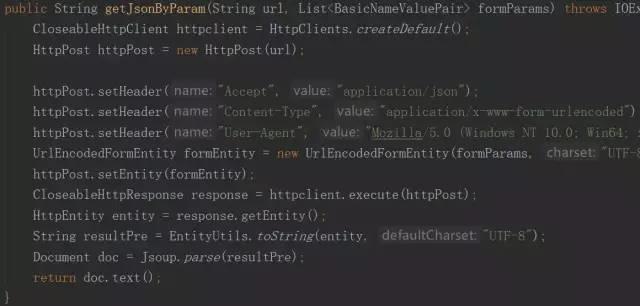转自:
Springboot — 用更优雅的方式发HTTP请求(RestTemplate详解) - Java知音号 - 博客园RestTemplate是Spring提供的用于访问Rest服务的客户端,RestTemplate提供了多种便捷访问远程Http服务的方法,能够大大提高客户端的编写效率。 我之前的HTTP开发是用ap https://www.cnblogs.com/javazhiyin/p/9851775.html
https://www.cnblogs.com/javazhiyin/p/9851775.html
RestTemplate是Spring提供的用于访问Rest服务的客户端,RestTemplate提供了多种便捷访问远程Http服务的方法,能够大大提高客户端的编写效率。
我之前的HTTP开发是用apache的HttpClient开发,代码复杂,还得操心资源回收等。代码很复杂,冗余代码多,稍微截个图,这是我封装好的一个post请求工具:

本教程将带领大家实现Spring生态内RestTemplate的Get请求和Post请求还有exchange指定请求类型的实践和RestTemplate核心方法源码的分析,看完你就会用优雅的方式来发HTTP请求。
1.简述RestTemplate
是Spring用于同步client端的核心类,简化了与http服务的通信,并满足RestFul原则,程序代码可以给它提供URL,并提取结果。默认情况下,RestTemplate默认依赖jdk的HTTP连接工具。当然你也可以 通过setRequestFactory属性切换到不同的HTTP源,比如Apache HttpComponents、Netty和OkHttp。
RestTemplate能大幅简化了提交表单数据的难度,并且附带了自动转换JSON数据的功能,但只有理解了HttpEntity的组成结构(header与body),且理解了与uriVariables之间的差异,才能真正掌握其用法。这一点在Post请求更加突出,下面会介绍到。
该类的入口主要是根据HTTP的六个方法制定:

此外,exchange和excute可以通用上述方法。
在内部,RestTemplate默认使用HttpMessageConverter实例将HTTP消息转换成POJO或者从POJO转换成HTTP消息。默认情况下会注册主mime类型的转换器,但也可以通过setMessageConverters注册其他的转换器。
其实这点在使用的时候是察觉不到的,很多方法有一个responseType 参数,它让你传入一个响应体所映射成的对象,然后底层用HttpMessageConverter将其做映射
| 1 2 |
HttpMessageConverterExtractor<T> responseExtractor =
new HttpMessageConverterExtractor<>(responseType, getMessageConverters(), logger);
|
HttpMessageConverter.java源码:
| 1 2 3 4 5 6 7 8 9 10 11 12 13 14 15 16 17 18 19 |
public interface HttpMessageConverter<T> {
//指示此转换器是否可以读取给定的类。
boolean canRead(Class<?> clazz, @Nullable MediaType mediaType);
//指示此转换器是否可以写给定的类。
boolean canWrite(Class<?> clazz, @Nullable MediaType mediaType);
//返回List<MediaType>
List<MediaType> getSupportedMediaTypes();
//读取一个inputMessage
T read(Class<? extends T> clazz, HttpInputMessage inputMessage)
throws IOException, HttpMessageNotReadableException;
//往output message写一个Object
void write(T t, @Nullable MediaType contentType, HttpOutputMessage outputMessage)
throws IOException, HttpMessageNotWritableException;
}
|
在内部,RestTemplate默认使用SimpleClientHttpRequestFactory和DefaultResponseErrorHandler来分别处理HTTP的创建和错误,但也可以通过setRequestFactory和setErrorHandler来覆盖。
2.get请求实践
2.1.getForObject()方法
| 1 2 3 |
public <T> T getForObject(String url, Class<T> responseType, Object... uriVariables){}
public <T> T getForObject(String url, Class<T> responseType, Map<String, ?> uriVariables)
public <T> T getForObject(URI url, Class<T> responseType)
|
getForObject()其实比getForEntity()多包含了将HTTP转成POJO的功能,但是getForObject没有处理response的能力。因为它拿到手的就是成型的pojo。省略了很多response的信息。
2.1.1 POJO:
| 1 2 3 4 5 6 7 8 9 10 11 12 13 |
public class Notice {
private int status;
private Object msg;
private List<DataBean> data;
}
public class DataBean {
private int noticeId;
private String noticeTitle;
private Object noticeImg;
private long noticeCreateTime;
private long noticeUpdateTime;
private String noticeContent;
}
|
示例:2.1.2 不带参的get请求
| 1 2 3 4 5 6 7 8 9 10 |
/**
* 不带参的get请求
*/
@Test
public void restTemplateGetTest(){
RestTemplate restTemplate = new RestTemplate();
Notice notice = restTemplate.getForObject("http://xxx.top/notice/list/1/5"
, Notice.class);
System.out.println(notice);
}
|
控制台打印:
| 1 2 3 4 5 6 7 |
INFO 19076 --- [ main] c.w.s.c.w.c.HelloControllerTest
: Started HelloControllerTest in 5.532 seconds (JVM running for 7.233)
Notice{status=200, msg=null, data=[DataBean{noticeId=21, noticeTitle='aaa', noticeImg=null,
noticeCreateTime=1525292723000, noticeUpdateTime=1525292723000, noticeContent='<p>aaa</p>'},
DataBean{noticeId=20, noticeTitle='ahaha', noticeImg=null, noticeCreateTime=1525291492000,
noticeUpdateTime=1525291492000, noticeContent='<p>ah.......'
|
示例:2.1.3 带参数的get请求1
Notice notice = restTemplate.getForObject("http://fantj.top/notice/list/{1}/{2}"
, Notice.class,1,5);
明眼人一眼能看出是用了占位符{1}。
示例:2.1.4 带参数的get请求2
| 1 2 3 4 5 |
Map<String,String> map = new HashMap();
map.put("start","1");
map.put("page","5");
Notice notice = restTemplate.getForObject("http://fantj.top/notice/list/"
, Notice.class,map);
|
明眼人一看就是利用map装载参数,不过它默认解析的是PathVariable的url形式。
2.2 getForEntity()方法
| 1 2 3 |
public <T> ResponseEntity<T> getForEntity(String url, Class<T> responseType, Object... uriVariables){}
public <T> ResponseEntity<T> getForEntity(String url, Class<T> responseType, Map<String, ?> uriVariables){}
public <T> ResponseEntity<T> getForEntity(URI url, Class<T> responseType){}
|
与getForObject()方法不同的是返回的是ResponseEntity对象,如果需要转换成pojo,还需要json工具类的引入,这个按个人喜好用。不会解析json的可以百度FastJson或者Jackson等工具类。然后我们就研究一下ResponseEntity下面有啥方法。
ResponseEntity、HttpStatus、BodyBuilder结构
ResponseEntity.java
| 1 2 3 4 5 6 7 8 9 |
public HttpStatus getStatusCode(){}
public int getStatusCodeValue(){}
public boolean equals(@Nullable Object other) {}
public String toString() {}
public static BodyBuilder status(HttpStatus status) {}
public static BodyBuilder ok() {}
public static <T> ResponseEntity<T> ok(T body) {}
public static BodyBuilder created(URI location) {}
...
|
HttpStatus.java
| 1 2 3 4 5 6 7 8 |
public enum HttpStatus {
public boolean is1xxInformational() {}
public boolean is2xxSuccessful() {}
public boolean is3xxRedirection() {}
public boolean is4xxClientError() {}
public boolean is5xxServerError() {}
public boolean isError() {}
}
|
BodyBuilder.java
| 1 2 3 4 5 6 7 8 |
public interface BodyBuilder extends HeadersBuilder<BodyBuilder> {
//设置正文的长度,以字节为单位,由Content-Length标头
BodyBuilder contentLength(long contentLength);
//设置body的MediaType 类型
BodyBuilder contentType(MediaType contentType);
//设置响应实体的主体并返回它。
<T> ResponseEntity<T> body(@Nullable T body);
}
|
可以看出来,ResponseEntity包含了HttpStatus和BodyBuilder的这些信息,这更方便我们处理response原生的东西。
示例:
| 1 2 3 4 5 6 7 8 9 10 11 12 13 14 15 16 17 18 19 20 21 22 23 24 25 |
@Test
public void rtGetEntity(){
RestTemplate restTemplate = new RestTemplate();
ResponseEntity<Notice> entity = restTemplate.getForEntity("http://fantj.top/notice/list/1/5"
, Notice.class);
HttpStatus statusCode = entity.getStatusCode();
System.out.println("statusCode.is2xxSuccessful()"+statusCode.is2xxSuccessful());
Notice body = entity.getBody();
System.out.println("entity.getBody()"+body);
ResponseEntity.BodyBuilder status = ResponseEntity.status(statusCode);
status.contentLength(100);
status.body("我在这里添加一句话");
ResponseEntity<Class<Notice>> body1 = status.body(Notice.class);
Class<Notice> body2 = body1.getBody();
System.out.println("body1.toString()"+body1.toString());
}
statusCode.is2xxSuccessful()true
entity.getBody()Notice{status=200, msg=null, data=[DataBean{noticeId=21, noticeTitle='aaa', ...
body1.toString()<200 OK,class com.waylau.spring.cloud.weather.pojo.Notice,{Content-Length=[100]}>
|
当然,还有getHeaders()等方法没有举例。
3. post请求实践
同样的,post请求也有postForObject和postForEntity。
| 1 2 3 4 5 |
public <T> T postForObject(String url, @Nullable Object request, Class<T> responseType, Object... uriVariables)
throws RestClientException {}
public <T> T postForObject(String url, @Nullable Object request, Class<T> responseType, Map<String, ?> uriVariables)
throws RestClientException {}
public <T> T postForObject(URI url, @Nullable Object request, Class<T> responseType) throws RestClientException {}
|
示例
我用一个验证邮箱的接口来测试。
| 1 2 3 4 5 6 7 8 9 10 11 12 13 |
@Test
public void rtPostObject(){
RestTemplate restTemplate = new RestTemplate();
String url = "http://47.xxx.xxx.96/register/checkEmail";
HttpHeaders headers = new HttpHeaders();
headers.setContentType(MediaType.APPLICATION_FORM_URLENCODED);
MultiValueMap<String, String> map= new LinkedMultiValueMap<>();
map.add("email", "[email protected]");
HttpEntity<MultiValueMap<String, String>> request = new HttpEntity<>(map, headers);
ResponseEntity<String> response = restTemplate.postForEntity( url, request , String.class );
System.out.println(response.getBody());
}
|
执行结果:
{"status":500,"msg":"该邮箱已被注册","data":null}

代码中,MultiValueMap是Map的一个子类,它的一个key可以存储多个value,简单的看下这个接口:
| 1 |
public interface MultiValueMap<K, V> extends Map<K, List<V>> {...}
|
为什么用MultiValueMap?因为HttpEntity接受的request类型是它。
| 1 2 |
public HttpEntity(@Nullable T body, @Nullable MultiValueMap<String, String> headers){}
//我这里只展示它的一个construct,从它可以看到我们传入的map是请求体,headers是请求头。
|
为什么用HttpEntity是因为restTemplate.postForEntity方法虽然表面上接收的request是@Nullable Object request类型,但是你追踪下去会发现,这个request是用HttpEntity来解析。核心代码如下:
| 1 2 3 4 5 6 7 |
if (requestBody instanceof HttpEntity) {
this.requestEntity = (HttpEntity<?>) requestBody;
}else if (requestBody != null) {
this.requestEntity = new HttpEntity<>(requestBody);
}else {
this.requestEntity = HttpEntity.EMPTY;
}
|
我曾尝试用map来传递参数,编译不会报错,但是执行不了,是无效的url request请求(400 ERROR)。其实这样的请求方式已经满足post请求了,cookie也是属于header的一部分。可以按需求设置请求头和请求体。其它方法与之类似。
4.使用exchange指定调用方式
exchange()方法跟上面的getForObject()、getForEntity()、postForObject()、postForEntity()等方法不同之处在于它可以指定请求的HTTP类型。

但是你会发现exchange的方法中似乎都有@Nullable HttpEntity requestEntity这个参数,这就意味着我们至少要用HttpEntity来传递这个请求体,之前说过源码所以建议就使用HttpEntity提高性能。
示例
| 1 2 3 4 5 6 7 8 9 10 11 12 13 14 15 |
@Test
public void rtExchangeTest() throws JSONException {
RestTemplate restTemplate = new RestTemplate();
String url = "http://xxx.top/notice/list";
HttpHeaders headers = new HttpHeaders();
headers.setContentType(MediaType.APPLICATION_FORM_URLENCODED);
JSONObject jsonObj = new JSONObject();
jsonObj.put("start",1);
jsonObj.put("page",5);
HttpEntity<String> entity = new HttpEntity<>(jsonObj.toString(), headers);
ResponseEntity<JSONObject> exchange = restTemplate.exchange(url,
HttpMethod.GET, entity, JSONObject.class);
System.out.println(exchange.getBody());
}
|
这次可以看到,我使用了JSONObject对象传入和返回。
当然,HttpMethod方法还有很多,用法类似。
5.excute()指定调用方式
excute()的用法与exchange()大同小异了,它同样可以指定不同的HttpMethod,不同的是它返回的对象是响应体所映射成的对象,而不是ResponseEntity。
需要强调的是,execute()方法是以上所有方法的底层调用。随便看一个:
| 1 2 3 4 5 6 7 8 9 10 |
@Override
@Nullable
public <T> T postForObject(String url, @Nullable Object request, Class<T> responseType, Map<String, ?> uriVariables)
throws RestClientException {
RequestCallback requestCallback = httpEntityCallback(request, responseType);
HttpMessageConverterExtractor<T> responseExtractor =
new HttpMessageConverterExtractor<>(responseType, getMessageConverters(), logger);
return execute(url, HttpMethod.POST, requestCallback, responseExtractor, uriVariables);
|



